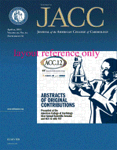JACC:血糖水平升高导致患心脏病风险增加
2012-06-18 Beyonf 生物谷
近日,一项哥本哈根大学的最新研究表明:血液中的葡萄糖水平增高会导致增加缺血性心脏病风险增高。这项研究涉及超过80,000人,研究论文发表在Journal of the American College of Cardiology杂志上。这项哥本哈根大学的新研究显示血糖略有升高对非糖尿病人罹患缺血性心脏病有一个更显著的风险。 研究团队对这些结果感到惊讶,因为到现在为止胆固醇被普遍认为是全球心脏健康
近日,一项哥本哈根大学的最新研究表明:血液中的葡萄糖水平增高会导致增加缺血性心脏病风险增高。这项研究涉及超过80,000人,研究论文发表在Journal of the American College of Cardiology杂志上。这项哥本哈根大学的新研究显示血糖略有升高对非糖尿病人罹患缺血性心脏病有一个更显著的风险。
研究团队对这些结果感到惊讶,因为到现在为止胆固醇被普遍认为是全球心脏健康的首要威胁。
我们知道,糖尿病和高胆固醇的人容易发生缺血性心脏病,但我们的研究也使人们看到血液中葡萄糖水平也对罹患心脏病有影响。哥本哈根大学副教授Marianne Benn说:令人惊讶的是甚至稍高的血糖值似乎是更危险的。
没有糖尿病的健康人正常空腹血糖小于6毫摩尔,然而,在Journal of the American College of Cardiology杂志上发表的研究报告显示血糖值长期只有1毫摩尔每升的人心脏病发作的风险增高到了69%以上。
利用与遗传分析相结合的方法。研究人员能够在80522名丹麦人中观察到哪些人血糖水平略有升高,而这一升高对自己的心脏有何损害。
科学家们认为葡萄糖直接影响缺血性心脏疾病的风险,但其中机制却仍不清楚,最后研究人员建议限制糖的摄入量,以减少患心脏疾病的风险。

doi:10.1016/j.jacc.2012.02.043
PMC:
PMID:
Nonfasting Glucose, Ischemic Heart Disease, and Myocardial Infarction
Marianne Benn, MD, PhD, DMSc*,,, Anne Tybj?rg-Hansen, MD, DMSc,,,||, Mark I. McCarthy, MD,#,**, Gorm B. Jensen, MD, DMSc,, Peer Grande, MD, DMSc, and B?rge G. Nordestgaard, MD, DMSc*,,,||,*
Objectives: The purpose of this study was to test whether elevated nonfasting glucose levels associate with and cause ischemic heart disease (IHD) and myocardial infarction (MI).
Background: Elevated fasting plasma glucose levels associate with increased risk of IHD, but whether this is also true for nonfasting levels and whether this is a causal relationship is unknown.
Methods: Using a Mendelian randomization approach, we studied 80,522 persons from Copenhagen, Denmark. Of those, IHD developed in 14,155, and MI developed in 6,257. Subjects were genotyped for variants in GCK (rs4607517), G6PC2 (rs560887), ADCY5 (rs11708067), DGKB (rs2191349), and ADRA2A (rs10885122) associated with elevated fasting glucose levels in genome-wide association studies.
Results: Risk of IHD and MI increased stepwise with increasing nonfasting glucose levels. The hazard ratio for IHD in subjects with nonfasting glucose levels 11 mmol/l (198 mg/dl) versus <5 mmol/l (<90 mg/dl) was 6.9 (95% confidence interval [CI]: 4.2 to 11.2) adjusted for age and sex, and 2.3 (95% CI: 1.3 to 4.2) adjusted multifactorially; corresponding values for MI were 9.2 (95% CI: 4.6 to 18.2) and 4.8 (95% CI: 2.1 to 11.2). Increasing number of glucose-increasing alleles was associated with increasing nonfasting glucose levels and with increased risk of IHD and MI. The estimated causal odds ratio for IHD and MI by instrumental variable analysis for a 1-mmol/l (18-mg/dl) increase in nonfasting glucose levels due to genotypes combined were 1.25 (95% CI: 1.03 to 1.52) and 1.69 (95% CI: 1.28 to 2.23), and the corresponding observed hazard ratio for IHD and MI by Cox regression was 1.18 (95% CI: 1.15 to 1.22) and 1.09 (95% CI: 1.07 to 1.11), respectively.
Conclusions: Like common nonfasting glucose elevation, plasma glucose-increasing polymorphisms associate with increased risk of IHD and MI. These data are compatible with a causal association
本网站所有内容来源注明为“梅斯医学”或“MedSci原创”的文字、图片和音视频资料,版权均属于梅斯医学所有。非经授权,任何媒体、网站或个人不得转载,授权转载时须注明来源为“梅斯医学”。其它来源的文章系转载文章,或“梅斯号”自媒体发布的文章,仅系出于传递更多信息之目的,本站仅负责审核内容合规,其内容不代表本站立场,本站不负责内容的准确性和版权。如果存在侵权、或不希望被转载的媒体或个人可与我们联系,我们将立即进行删除处理。
在此留言














#JACC#
67
#血糖水平#
63
#ACC#
49
#心脏病风险#
58
#心脏病风险#
62